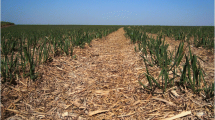Abstract
Sweet sorghum (Sorghum bicolor (L.) Moench) is currently recognized throughout the world as a highly promising biomass energy crop. Production systems and management practices for sweet sorghum have not been fully developed for the USA, although sporadic research efforts during recent decades have provided some insights into production of sweet sorghum primarily for fermentable sugar production. Field plot experiments were conducted at sites across Louisiana to assess biomass and sugar yield responses to N fertilizer, plant density, and selected cultivars. Although linear increases in stem biomass production and fermentable sugar yield were obtained with increasing N fertilizer rate under irrigated conditions, most of the increase was from the initial 45 kg N ha−1 increment. Nitrogen fertilization increased stem biomass production but not fermentable sugar yield in some non-irrigated environments. Increased plant density contributed to fermentable sugar yield only under growth-limiting conditions, particularly under limited soil moisture. Location effects indicate that sweet sorghum may not be suitable for some sub-optimal cropland and pasture environments in Louisiana. During the primary growing season, cultivar did not affect fermentable sugar yields, although Dale was consistently high in sugar concentration during this period. Nitrogen fertilizer increased fermentable sugar yields only when moisture was not limiting. Overall results indicate that in environments where soil moisture limits plant growth, sugar yield responses are likely from increased plant density and not from increased N fertilization.
Similar content being viewed by others
References
Ture S, Uzun D, Ture IE (1997) The potential use of sweet sorghum as a non-polluting source of energy. Energy 22:17–19
Antonopoulou G, Gavala HN, Skiadas IV, Angelopoulos K, Lyberatos G (2008) Biofuels generation from sweet sorghum: fermentative hydrogen production and anaerobic digestion of the remaining biomass. Bioresour Technol 99:110–119
Reddy BVS, Ramesh S, Reddy PS, Ramaiah B, Salimath PM, Kachapur R (2005) Sweet sorghum - a potential alternate raw material for bio-ethanol and bio-energy. Int Sorghum Millets Newsl (Int Crops Res Inst Semi-Arid Tropics) 46:79–86
Nguyen MH, Prince RGH (1996) A simple rule for bioenergy conversion plant size optimisation: bioethanol from sugar cane and sweet sorghum. Biomass Bioenergy 10:361–365
Zhang C, Xie G, Li S, Ge L, He T (2010) The productive potentials of sweet sorghum ethanol in China. Appl Energy 87:2360–2368
Morris BD, Richardson JW, Frosch BJ, Outlaw JL, Rooney WL (2009) Economic feasibility of ethanol production from sweet sorghum juice in Texas. Agricultural & Food Policy Center, Department of Agricultural Economics, Texas A&M University, College Station
Wortmann CS, Liska AJ, Ferguson RB, Lyon DJ, Klein RN, Dweikat I (2010) Dryland performance of sweet sorghum and grain crops for biofuel in Nebraska. Agron J 102:319–326
Tew TL, Cobill RM, Richard EP Jr (2008) Evaluation of sweet sorghum and sorghum × sudangrass hybrids as feedstocks for ethanol production. Bioenergy Res 1:147–152
Horton DS, Rushing JB, Baldwin BS (2010) Sweet sorghum, a better source of ethanol. The Association for the Advancement of Industrial Crops. Accessed on-line 16 March 2010 from http://www.aaic.org/08program.htm
Smith GA, Bagby MO, Lewellan RT, Doney DL, Moore PH, Hills FJ et al (1987) Evaluation of sweet sorghum for fermentable sugar production potential. Crop Sci 27:788–793
Worley JW, Cundiff JS, Vaughan DH, Parrish DJ (1991) Influence of sweet sorghum spacing on stalk pith yield. Bioresour Technol 36:133–139
Broadhead DM, Freeman KC (1980) Stalk and sugar yield of sweet sorghum as affected by spacing. Agron J 72:523–524
Lueschen WE, Putnam DH, Kanne BK, Hoverstad TR (1991) Agronomic practices for production of ethanol from sweet sorghum. J Prod Agric 4:619–625
Tamang PL, Bronson KF, Malapati A, Schwartz R, Johnson J, Moore-Kucera J (2011) Nitrogen requirement for ethanol production from sweet and photoperiod sensitive sorghums in the southern High Plains. Agron J 103:431–440
Hills FJ, Johnson SS, Geng S, Abshahi A, Peterson GR (1981) Comparison of high-energy crops for alcohol production. California Agric Nov.-Dec:14–16
Turgut I, Bilgili U, Duman A, Acikgoz E (2005) Production of sweet sorghum (Sorghum bicolor L. Moench) increases with increased plant densities and nitrogen levels. Acta Agric Scandinavica Section B —Plant Soil Science 55:236–240
Soileau JM, Bradford BN (1985) Biomass and sugar yield response of sweet sorghum to lime and fertilizer. Agron J 77:471–475
SAS Institute (2004) SAS/STAT User’s Guide (Verl 9.1.3 Service Pack 4). SAS Institute Inc, Cary
Mitchell RL (1970) Crop growth and culture. Iowa State University Press, Ames
Ferrar R, Charles-Edwards DA (1986) A comparative analysis of the growth of sweet and forage sorghum crops. 1. Dry matter production, phenology and morphology. Aust J Agric Res 37:495–512
Steiner JL (1986) Dryland grain sorghum water use, light interception, and growth responses to planting geometry. Agron J 78:720–726
Curt MD, Fernandez J, Martinez M (1998) Productivity and radiation use efficiency of sweet sorghum (Sorghum bicolor (L.) Moench) cv. Keller in central Spain. Biomass Bioenergy 14:169–178
Dercas N, Liakatas A (2007) Water and radiation effect on sweet sorghum productivity. Water Resour Manage 21:1585–1600
Martin CE, Trahan LJ, Midkiff CT (1981) Soil Survey of Franklin Parish, LA. USDA, SCS, Alexandria
Baligar VC, Schaffert RE, Dos Santos HL, Pitta GVE, Bahia Filho AF (1993) Soil aluminium effects on uptake, influx, and transport of nutrients in sorghum genotypes. Plant Soil 150:271–277
Krishnamurthy L, Serraj R, Hash CT, Dakheel AJ, Reddy BVS (2007) Screening sorghum genotypes for salinity tolerant biomass production. Euphytica 156:15–24
Almodares A, Hadi MR, Ahmadpour H (2008) Sorghum stem yield and soluble carbohydrates under different salinity levels. African J Biotechnol 7:4051–4055
Acknowledgments
This work was supported through funding from the American Sugarcane League and the Louisiana Agricultural Experiment Station. All scientific aspects of the research and subsequent preparation for publication were provided by the authors as employees of the Louisiana Agricultural Experiment Station.
Author information
Authors and Affiliations
Corresponding author
Rights and permissions
About this article
Cite this article
Han, K.J., Pitman, W.D., Alison, M.W. et al. Agronomic Considerations for Sweet Sorghum Biofuel Production in the South-Central USA. Bioenerg. Res. 5, 748–758 (2012). https://doi.org/10.1007/s12155-012-9185-3
Published:
Issue Date:
DOI: https://doi.org/10.1007/s12155-012-9185-3




